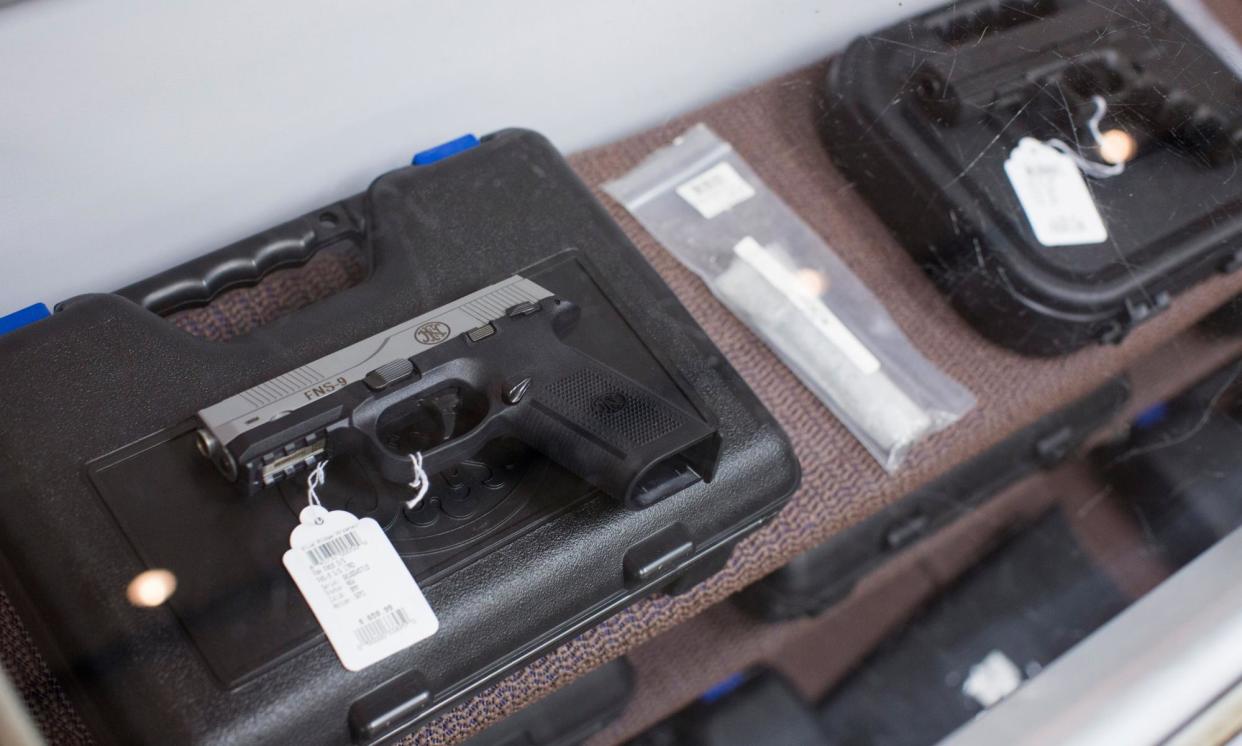Will ‘sigh of relief’ after US supreme court gun ruling be short-lived?

The US supreme court decided to uphold a 30-year-old federal law prohibiting subjects of domestic violence restraining orders (DVROs) from possessing guns. In Friday’s 8-1 decision, justices – except Clarence Thomas – agreed that Zackey Rahimi’s constitutional rights were not violated when his guns were confiscated following a lengthy history of gun crimes and abuse against his then girlfriend and mother of his child.
While the ruling is not a surprise to many experts who heard the 7 November 2023 oral argument, it represents a small victory for those who advocate for protection orders like DVROs and work with survivors of domestic abuse.
“I think we’re all breathing a sigh of relief that the court did not decide to put more people in direct risk of being killed or seriously injured,” said Kelly Roskam, director of law and policy for the Johns Hopkins Center for Gun Violence Solutions. “There seemed to be a general acceptance among the justices that there is this national historical tradition of disarming people who are dangerous.”
The case focused on Rahimi, a Texas man who assaulted his then girlfriend and the mother of his child in a parking lot in 2019. When bystanders noticed, he pulled out a gun and fired a shot. The woman, referred to as CM in court documents, managed to get away, but Rahimi threatened to shoot her if she reported the incident, the majority opinion written by Chief Justice John Roberts read. Despite the threat, the woman sought and was granted a restraining order by a judge.
But the order didn’t deter Rahimi, who continued to contact CM via social media and showed up at her home. He was also a suspect in another five shootings. Rahimi was indicted for possessing a firearm while being subject to a DVRO, but he moved to have the indictment dismissed, arguing that the original order and criminal code it was based on, 922(g), which prohibits people under DVROs from having firearms and ammunition, violated his constitutional rights.
Despite his history, the fifth circuit court of appeals sided with Rahimi and based its judgment on a rule created by the highly controversial 2022 Bruen decision, which voided many state restrictions on carrying firearms in public and established a new standard for gun regulations, requiring laws to be “consistent with the nation’s historical tradition of firearm regulation”, according to justice Thomas’s majority opinion for Bruen.
Friday’s decision by the supreme court is in direct rebuke of the fifth circuit ruling, with Roberts admonishing the panel for “misapplying the court’s precedent” when reviewing Rahimi’s case. Roberts added that the disarming of anyone who is found to pose a credible threat to the physical safety of an intimate partner or parent of their child is consistent with the second amendment.
“When a restraining order contains a finding that an individual poses a credible threat to the physical safety of an intimate partner, that individual may – consistent with the second amendment – be banned from possessing firearms while the order is in effect,” Roberts wrote.
While the decision upholds a 30-year-old federal law, it also leaves the door open for people to bring new court challenges if they believe that a judge placed them under a DVRO erroneously.
“I would say to a fairly high degree of certainty, somebody will bring an ‘as-applied’ challenge to the same law,” said Clark Neily, senior vice-president for legal studies at the Cato Institute. “Someone will say: ‘I’m not asking for a ruling across the board. I’m simply asking for a ruling that has applied to me personally.’”
Neily, who was a constitutional litigator for 17 years, added that the second amendment, unlike the first, which grants the right to free speech, has not been as refined through supreme court decisions. Also, he said, Rahimi and subsequent cases will continue to set precedents for the ways the second amendment can be applied.
“There will be sympathetic second-amendment poster children who go to the court, and there’ll be unsympathetic ones, and that’ll just keep going back and forth,” Neily added. “So it’s nothing new. It’s just happened that [the supreme court] got a later start with a second amendment.”
Although this was the first case decided in the shadow of the Bruen decision, it almost certainly will not be the last. Waiting in the wings are cases from Pennsylvania and Florida that will determine whether a man with a 30-year-old food-stamp fraud conviction and marijuana users, respectively, will be able to own guns.
As these cases make their way through the courts, advocates who rely on policies such as 922(g) and other firearm prohibitions say that they are prepared to continue their efforts to disarm people who are a threat to the life and safety of those closest to them.
“We have a culture of firearms ownership in the United States, and when you talk about taking someone’s firearms, even for a limited duration … people get uncomfortable with that even though we know that there is a direct correlation between domestic violence and the presence of firearms increasing lethality,” said Millicent Shaw Phipps, legal director at Ujima, a non-profit that supports Black women dealing with domestic violence.
“We’ll all brace up and prepare, and get ready for the next court case or whatever other impact litigation is out there to remove firearms for people who shouldn’t have them,” echoed Gretta Gardner, chief legal officer of Ujima.


